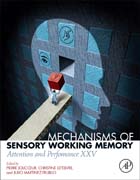
Mechanisms of Sensory Working Memory: Attention and Perfomance XXV
Jolicoeur, Pierre
Martinez-Trujillo, Julio
Working memory processes are crucial for many facets of cognitive processing and experience. Working memory acts as the interface between perception, action, and long-term memory. Historically, working memory was studied using verbal stimuli, spoken or written words. Recently, many researchers in the field have started to understand working memory for features of stimuli devoid of verbal, phonological, or long-term memory content, such as memory for simple visual features (e.g., texture or color), simple auditory features (e.g., pitch), or simple tactile features (e.g., vibration frequency), now called sensory memory to distinguish from verbal memory. Results have helped cognitive neuroscientists to understand basic memory mechanisms in each of these sensory systems without confounding influences of other memory systems (e.g., verbal memory). The contemporary focus on sensory memory is just beginning and this collection of original contributions provides a foundational reference for the study mechanisms of sensory memory. This will be of great interest to students, scholars and researchers in cognitive neuroscience, cognitive science, neuroscience and psychology studying memory mechanisms and processes. Introduces the study of Sensory Mechanisms of Working Memory as distinct from Verbal MemoryCovers Visual Memory, Auditory Memory and Tactile MemoryIncludes translational content since the breakdown of working memory is often associated with a disease, disorder or trauma to the brain INDICE: Sensory Mechanisms of Working Memory Section1: Working Memory for Sensory Attributes Section 2: Visual Working Memory Section 3: Auditory Working Memory Section 4: Tactile Working Memory
- ISBN: 978-0-12-801371-7
- Editorial: Academic Press
- Encuadernacion: Cartoné
- Páginas: 528
- Fecha Publicación: 13/10/2015
- Nº Volúmenes: 1
- Idioma: Inglés
